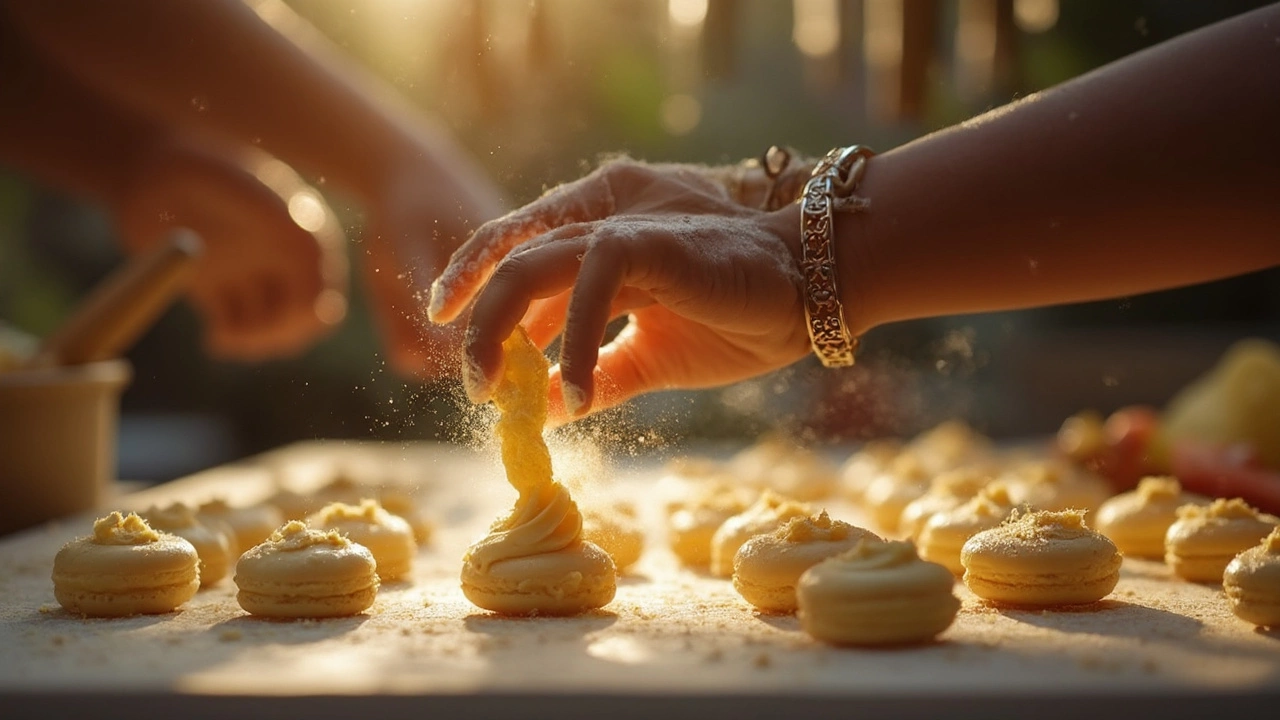Ah, macarons. Those colorful, perfectly round cookies with their delicate crunch and soft, chewy centers. Sounds dreamy, right? Until your batch comes out all cracked. Don't worry, you're not alone. Let's break down what might be going wrong.
First off, it’s all about balance. Too much mixing and your batter just might collapse, leading to those unfortunate craters. Not enough, and you have lumps and no feet—a macaron's signature rise. It’s like Goldilocks and the Three Bears; you gotta find that ‘just right’ middle ground.
Then there’s the oven, your macaron's frenemy. Ever notice how they cook unevenly? That could be a sign of hot spots or temperature fluctuations. An oven thermometer can be your best buddy here, ensuring everything stays as it should.
And boy, does humidity play a part! If it’s too moist, your shells may not develop that skin that’s crucial for even baking and preventing cracks.
So, while these cookies can give you a run for your money, understanding these quirks can turn frustration into flawless desserts. Let’s troubleshoot this together and make those macarons a masterpiece!
- The Science Behind Macarons
- Common Causes of Cracking
- The Art of Mixing
- Temperature and Timing
- Fixing Cracks and Preventing Them
The Science Behind Macarons
Alright, let's get into the nitty-gritty of why these cute sweets act that way. At its core, making macarons is all about chemistry and physics. Sounds intense? It kinda is, but don't sweat it. Understanding the science can really help us nail the perfect macaron.
So, macarons start with two main stars: almond flour and meringue (that's whipped egg whites and sugar). When you mix these, you're essentially marrying air and texture. The trick is to fold just enough air into the batter. If you go overboard, you risk having your macarons crack or be too flat. Think of it like trying to make the fluffiest pillow ever.
Next up, the whole drying process. Ever wondered why recipes tell you to let your macarons sit before baking? It's not just tradition—it's about forming a skin. This skin keeps the air inside from escaping too quickly and helps the macarons rise evenly. Skipping this step? Say hello to cracks and rocky textures.
And then there's your oven. Macarons need an exact temperature to rise and develop those delightful 'feet'. Too hot, and they might explode like fireworks. Too cold, and they could end up flat and sad. It's a tightrope walk for sure.
Oh, and don't ignore the impact of environmental conditions, like humidity! A humid day can throw a wrench in your plans because moisture affects how macarons dry and bake. Keeping an eye on this can save you a lot of heartache.
So now you know: macarons are like little science experiments you can eat. And understanding this science? Totally your superpower for macaron success!
Common Causes of Cracking
So, why do those elusive macarons crack? Knowing the usual culprits can save you from a lot of kitchen heartbreak. First up, over-mixing can be a big problem. If you mix your ingredients too thoroughly, you'll knock out all the air and make your batter too runny. This leads to spreading, and voilà—cracks.
Then there's the flip side: under-mixing. If you don't mix enough, your batter won't be smooth and could have lumps. This affects how the heat disperses in the oven, creating those annoying cracks again.
Let's chat oven temperatures. Macarons are super sensitive about how they're baked. Too hot, and they rise too quickly, causing cracks. Too cold, and they might not even rise at all, creating flat discs of disappointment. A thermometer, to double-check your oven's mood swings, can be a lifesaver.
Don't forget about humidity. Moist air can mess with the drying process of your macarons. If they don't form a proper skin before baking, they might explode like little volcanoes in the oven. Using a fan to circulate air or avoiding rainy days for baking can help.
Baking sheets and parchment paper are also players here. Using warped or thin sheets can cause uneven heating. Make sure you're using heavier, thicker sheets to help distribute the heat evenly and keep everything steady.
Here's a quick table to sum up the common issues and solutions:
| Issue | Solution |
|---|---|
| Over-Mixing | Stop when batter flows like lava |
| Under-Mixing | Mix until smooth and combined |
| High Oven Temp | Check with an oven thermometer |
| Humidity | Bake on dry days or use a fan |
| Bad Baking Sheets | Use thick, heavy-duty sheets |
By knowing these common culprits, you'll be one step closer to avoiding cracked macarons. Once you've got these mastered, you're on your way to cookie perfection!

The Art of Mixing
Alright, buckle up, because nailing the art of mixing can make or break your macarons. It’s like the secret sauce of the whole process. But don’t worry, by the end of this, you'll feel like a macaron master.
First things first, you want to achieve that perfect ‘macaronage.’ Yeah, that’s the fancy term for mixing your batter to the right consistency. It should flow like lava—smooth and slightly glossy, not too runny or stiff. The goal here is to gently deflate the meringue but not completely destroy it.
Here’s a simple trick: Scoop up some batter with a spatula, let it fall back into the bowl, and if it makes a figure-eight without breaking, you’re on the right track. Too many figure-eights and you’re in over-mixed territory, leading straight to cracked macarons.
But wait, there’s more to watch out for! You should always fold the batter with care; circle along the bowl's wall and cut through the middle. This keeps air in your meringue while reaching that silky consistency.
And here’s a pro tip: When incorporating dry ingredients, sift them twice. This not only removes lumps but helps fold them in evenly, reducing the risk of over-working the batter.
Lastly, don't rush. The feeling of impatience grows when those colorful cookies are the prize, but patience is truly a virtue here. Take your time mixing. Understanding how your batter moves is key.
Get this mixing right, and you’ll be that much closer to mastering these notoriously tricky treats. Your future self (and any macaron-loving friends) will thank you!
Temperature and Timing
Getting the temperature and timing spot-on is like the secret handshake to unlocking perfect macarons. These factors are crucial in preventing those pesky cracks. The first thing you want to do is make friends with an oven thermometer. Why? Because even if you've got your oven set to 300°F, it might actually be 320°F in there, throwing off your whole batch.
Consistency is key here. Most folks bake their macarons at around 300°F to 325°F, but every oven’s got its own personality. Spend time finding the sweet spot for yours. You’ll want to aim for a stable temperature throughout the baking process.
Timing-wise, leave the shells out to dry for about 20-40 minutes before baking. This allows the outer layer to form a skin. It’s this skin that helps the macaron rise evenly without cracking. Give it a little nudge with your finger; if it doesn’t stick, you’re good to go.
When baking, rotation is your friend, too. Sometimes ovens don’t distribute heat evenly, so a quick middle-of-the-bake spin of the tray can ensure even cooking. This little movement is often the difference between a smooth shell and a cracked one.
And while we’re discussing things like pros, remember to give those macarons a quick peek through the oven window. Though tempting, cracking that door open too early can cause temperature drops, which lead to—you guessed it—cracks!
Experiment and keep track of your results. Jot down times, temps, and tweaks you make, so you know what works best for recreating that flawless batch time and time again.

Fixing Cracks and Preventing Them
Alright, you've pulled your macarons out of the oven, and those annoying cracks are there again. First, take a deep breath. It's fixable! Let's go over some ways to correct and prevent these cracks.
Start by keeping an eye on how you're handling the batter. Over-mixing or under-mixing can be a major culprit. Aim for a batter that flows like lava—that is, it should slowly ooze in the bowl. Not too runny, not too stiff.
Next, preheating your oven correctly is crucial. Use an oven thermometer to ensure the inside is at the exact temperature you need. A too-hot oven can lead to skin forms that burst open at the first sign of heat.
Here's another tip: let them sit before they're baked. This waiting period helps the shells form a skin, creating a shield for the fragile interior. Aim for 30 minutes up to an hour, depending on humidity in your kitchen.
Oh, and speaking of humidity, it’s a sneaky player in this game. On humid days, you might find your macarons taking forever to dry. Consider using a dehumidifier in your kitchen to keep things just right.
Here's a little cheat if you're desperate: tap the tray on the counter a few times before baking to remove air bubbles from the batter. It sounds simple, but it’s effective!
If you’ve already baked them and can't stand the cracks, try this rescue method: sandwich those cracked shells and hide the flaws with extra filling. Trust me, nobody will complain about more chocolate ganache or raspberry jam.
Preventing these mishaps takes practice, but with these tweaks, you’ll be a macaron master in no time. Remember, all those little steps make a difference, so be patient and enjoy the process. Happy baking!